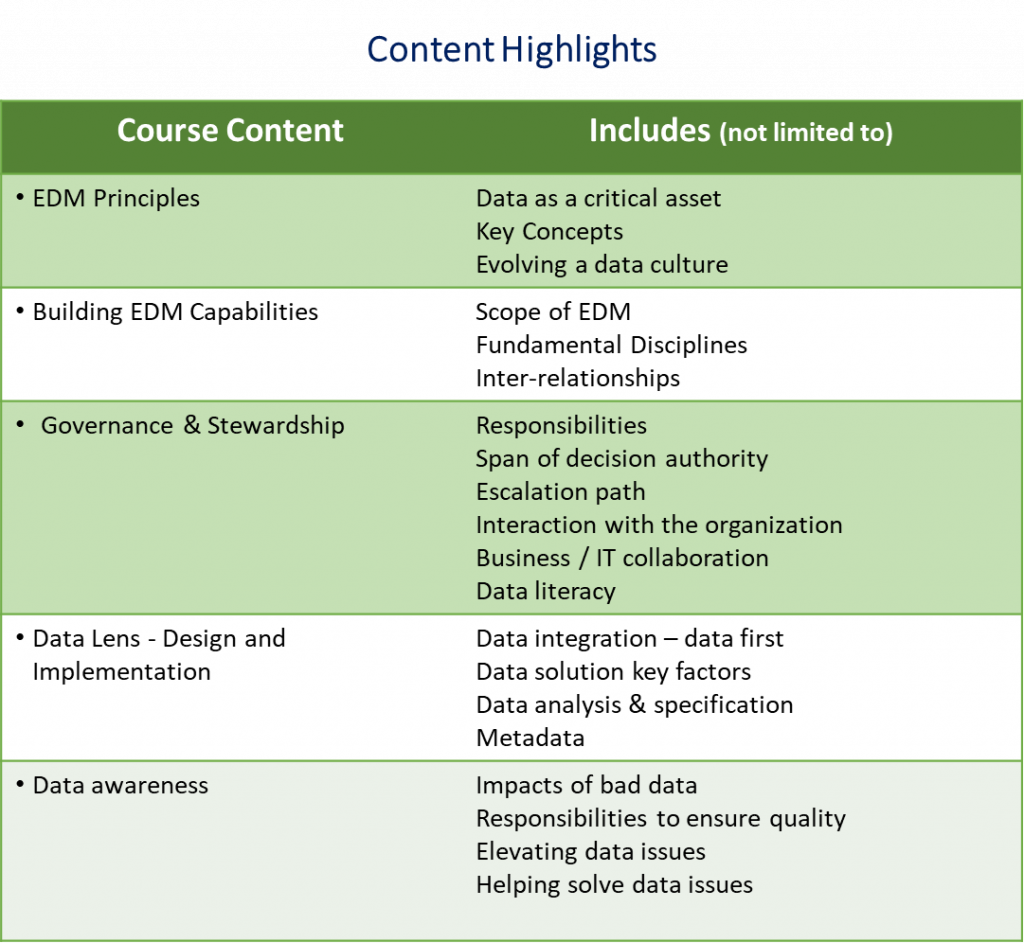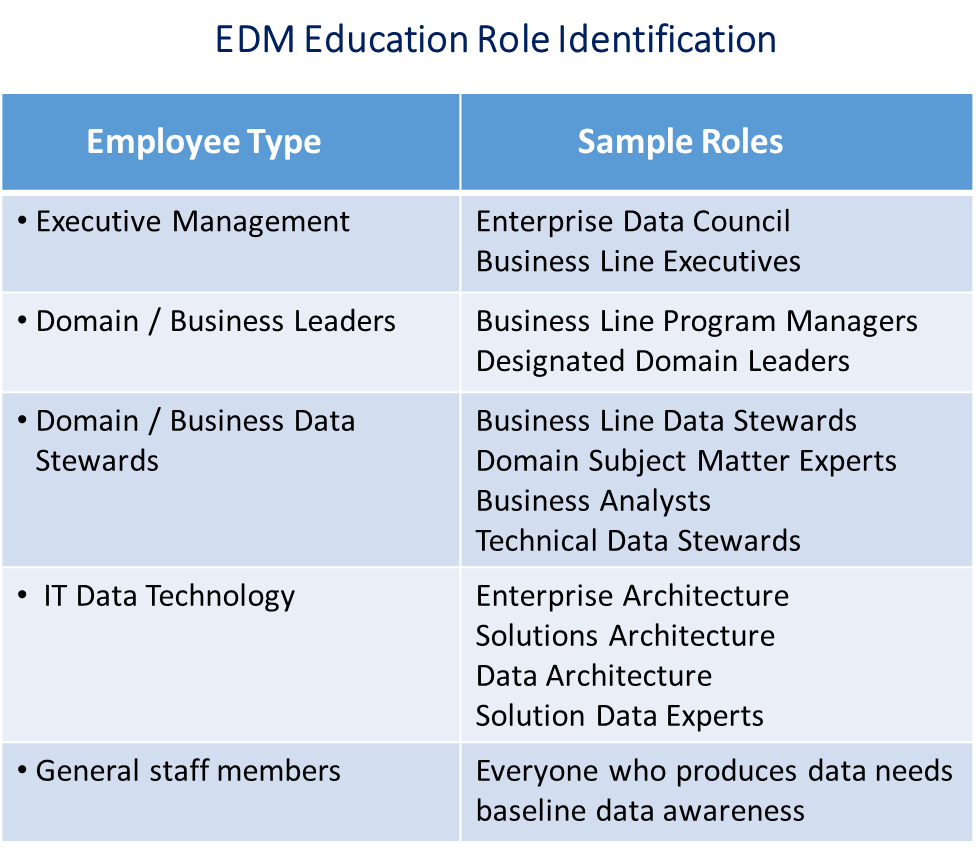
In my work with the EDM Council’s Data Management Capability Assessment Model (DCAM) 3.0 development group, we are adding a capability that has remained under the radar in our industry, that is, the responsibility of the Data Management Program to determine concept and knowledge gaps within its staff resources. The organization should then plan, organize, and make a commitment to establishing a thoughtful, responsive approach to uplifting staff understanding and knowledge.
Like the Data Management Program itself, data management education should be a sustained function that evolves over time. In this column, we will propose perspectives, structures, approaches, and activities to help an organization establish and successfully manage an organization-wide education program.
In the first column, we focused on why EDM Education is needed. This second column will focus on what learning objectives it should deliver, and who needs it. In the third column, we will address when it is needed, creating an education plan, discipline training, and associated metrics, certifications, and how education should be conducted, including learning techniques and tips to help make your courses interesting and effective.
Let’s dive right in: A notional list of useful educational courses for any organization with a Data Management Program is depicted in the table below.
Is this everything? No, not by a long shot, but it will get us started.
I spoke with Deborah Henderson, Managing Author of the DMBOK 1.0 and the DAMA Dictionary of Data Management, driving engine for most of the DMBOK 2.0, Master CDMP, DAMA Fellow, and past DAMA Foundation President1 for this column. From her extensive teaching experience, she has observed that “Most people have no perception of data as such; they think in the context of systems, screens, and reports.” I think we can agree that this is the typical scenario in many organizations. Deborah recommends spotlighting the importance of data through clear definitions of terms and concepts, for everyone who uses or produces data, clarifying how data is separate from applications.
Starting at the bottom of the list, let’s outline some suggested topics to address in a foundational Data Literacy (aka, Data Awareness, Introduction to Data) course, intended for all staff who either define, produce, or use data or reports — from the summer intern to the CEO.
Since you’re aiming at a very broad audience, the recommended format is CBT, and the recommended length is 15-25 minutes — a condensed elevator concept pitch, with examples relevant to the organization. Ideally, your top data executive will make this course mandatory. (More about planning and rollout in the Education Plan in the next column). The minimum everyone needs to understand includes:
- Systems (screens, business rules, and reports) are built to capture, store, and modify data — data is the POINT, not a by-product of features.
- Everyone who uses and produces data should help to ensure good data.
- Correct data entry is important — follow procedures, validate and be consistent.
- Quality data begins with you — if it’s broken, raise the issue and help to fix it.
- Participate in a data working group — work with peers to solve problems.
- Elevate data issues to management.
The Data Lens course (working title, change freely) is aimed at technical data stewards and those responsible for designing data stores and interfaces (bulk or point to point), migrating data, integrating data, technical evaluation of vendor products, and capturing, storing, and publishing technical and operational metadata. The rationale for a course targeting this audience is to harmonize what IT does with what business line data governance and the DM Program strategy is trying to accomplish.
Over my career, I’ve worked with over a hundred IT project teams — in roles including ensuring data standards compliance, reviewing data models against system requirements, instituting data design best practices, training on data requirements and data preparation specifications, mapping custom data structures to vendor products, and overall, mentoring developers and development DBAs about “what to do with the data part of the solution.”
Bottom line, information technology is perennially BUSY. They are always marching to schedule and budget, most of their projects are under systems lifecycle phase requirements and approvals (whether waterfall, agile, or hybrid), and their mission is to satisfy the business owner who is paying the bills. Therefore, IT is often the LAST group in the organization to come on board the data train (sad, but true).2
Since it’s difficult to get executives to mandate process or procedural changes within IT itself (worry about those deadlines and budget constraints), education is the second line of defence. If we can reach all those developers, etc., and inculcate key principles, we’ll have a fighting chance at getting them to read and apply the data management policies, processes, and standards, and move towards an improved state of business-as-usual.3 The minimum they need to understand includes:
- Think about the data — BEFORE you select technologies, toolsets, or platforms, BEFORE you design the database or specify interfaces, WHILE developing functional requirements, APPROVING data maps before migration, USING published data standards, etc.
- Check for enterprise data — Make it your business to find out if, and where, shared data has already been defined, in business term lists, in metadata repositories, in shared data stores, in master data hubs, etc. (aka, ‘for Pete’s sake, don’t create another version of Customer, or Patient, or Product, just to meet a deadline’).
- Improve data requirements and interface specifications — Don’t let the development DBA design the database on the fly. Clearly specify data requirements, do a data model and have it reviewed, and document those interfaces and web services.
- Expand your interactions with data management, governance, and the business lines — From the IT perspective, identify both your immediate and extended stakeholders. In other words, be proactive, don’t seek forgiveness later. (As the DM Program, we’re playing the long game – every deviation adds complexity to the data assets, increases steady state spend, makes integration more difficult, and makes analytics more complex).
- It is your problem — If the organization has committed to a DM program (and since IT holds up half the sky) it is imperative that they “get religion,” or the curve of progress will be unduly flattened.
- You’re accountable for metadata — The organization needs information about its data assets. IT needs to take responsibility for capturing, storing, and making available technical and operational metadata. E.g., you can’t do data lineage without it, etc.
The DM Program needs to be both a partner, supporter, and a gadfly to IT, which may be a big part of the problem, but can easily become a big part of the solution. Offer them a course and encourage (if you can’t mandate) them to take it. Order pizza, bring snacks, whatever it takes.
Governance and Stewardship education is vital for equipping the organization to make effective decisions about and institute appropriate accountability and controls for enterprise data. For those who are recognized with an active role in the data governance workstream (a permanent function — mutual decision making about shared data), they need to learn their role — what activities they’ll be expected to participate in, what they’re accountable for, etc. — become familiar with key concepts, learn how governance interacts with the rest of the organization, and have a comprehensive understanding of data impacts and how they can help improve the organization’s data. Topics should include, at a minimum:
- Governance structure — The goals and objectives of the data governance in the organization and the hierarchy of governance components it has established
- Governance policy and processes — The organization’s data governance policy, and the business processes that are carried out by governance actors in the established hierarchy, including data definition, domain identification of data sets, business metadata, decision processes, issue escalation processes, granting data access, workflow management, etc.
- Governance Interaction model (aka, Operating Model) — How data governance interacts with other organizational units, such as business lines, IT, data management, etc.
- Responsibilities — What the individual’s designated role implies for expected tasking, estimated time commitments, types of work, accountability, etc. — ideally the course would include, for participants at each level, the specific type of collaborative decisions they are expected to address in multiple data management processes as they arise, e.g., data quality, data architecture, metadata, data requirements specification, etc.4
- Span of decision authority — To whom they report for governance activities, to whom they may delegate, with whom they seek input on shared data decisions, when they are the sole decision authority, etc.
- Business / IT collaboration — How a governance participant interacts with IT for technology selection, vendor product migration, data store design, data integration affecting their data set(s), approvals, etc.
- Data literacy — Deep dive on data impacts pertinent to reporting, modelling, and analytics, and how this expands the governance knowledge base and role.
In the next column, we’ll address skills education that is very useful for business and technical data stewards and data domain leaders, including:
- How to read (and review) a data model
- How to write data requirements
- How to write quality rules
- How to determine quality thresholds and targets
- How to analyze business processes for data implications
- How to define business terms
- How to determine the business metadata you require
- How to engage in external data source selection
- How to work with IT on projects
- How to lead data-focused teams
- How to determine security and privacy requirements
- How to engage in policy development efforts, etc.
World-class data stewards need to have familiarity with these skills and techniques. It makes the job more enjoyable, because mastery of any skill is intrinsically satisfying (and we want governance participation to be both energetic and sustained over time). As George Leonard expressed it, “The essence of boredom is to be found in the obsessive search for novelty. Satisfaction lies in mindful repetition, the discovery of endless richness in subtle variations on familiar themes.” For example, ‘Now that we all agree on the definition and values for ‘Customer Role Type,’ we can move onto ‘Customer Activity Code,’ and it will be a faster process — we rock!’
Jumping the line here in the Content Highlights chart, let’s talk about what an organization’s senior executives need to learn to be informed advocates of the DM Program. Having interviewed numerous of executives in this context, I have several general suggestions:
- Executive time is even more precious than staff time, so keep it short, no more than 3-4 hours in length.
- Rehearse your course / workshop facilitation to the letter — when they take out cell phones or start answering emails, you’ve lost them.
- They analyze and green-light decisions based on the business strategy, goals, and KPIs, so make sure that your materials address how DM contributes to the success of key planned or in-flight initiatives (representing funding they’ve already committed, and for which they expect bang-up results).
- Research their key data challenges and opportunities in advance as far as possible — this is priming the pump to help you make the session more interactive.
- Don’t contradict them — find another way to convey the concept.
- Finally, half of the course should consist of elicitation of their perspectives and concerns about the organization’s data (they talk, you listen and engage their peers to respond) so include important discussion questions aimed at discovering what they view as persistent data problems, as well as their business aspirations.
The content (your portion) should include:
- The importance of active executive engagement to implement and sustain the DM Program — proposed leadership/interaction suggestions that have proven to be effective.
- Leading by example to demonstrate that the data assets are critical — what it means to be a data-driven organization.
- How a focus on data and implementing solid data management policies, processes and practices enables the cutting-edge solutions that the vendors want to sell them — data lakes, machine learning, artificial intelligence — accelerated discovery of patterns, trends, and future-casting.
- How an EDM Program will result in cost savings over time — show them a well-reasoned return on investment.
- A reasonable timeframe and estimated staff effort — what it will take to build a great program that meets their business needs.
- How organizational factors can accelerate or impede the DM Program.
- Factors for prioritization of data-centric business cases.
Since we’re recommending that the content be customized to the organization, you can add other topics that are appropriate. For example, if they have just launched an DM Program, you can address the rationale for critical workstream dependencies, ask them to give their point of view about data domain priorities, etc.
If you design the executive course / workshop well and deliver it confidently and crisply, you will not only create advocacy for EDM (a consummation devoutly to be wished), but you will emerge with considerations for enhancing the EDM Strategy and refinements to the EDM Program. If you make the most of this opportunity, it has the potential to benefit many initiatives and raise the profile of EDM in the organization.
The purpose of DCAM Plus/Building EDM Capabilities is to accelerate the progress and enhancement of the DM Strategy and corresponding DM Program. It should be de rigueur for all data management professionals and data management leadership, as it provides both the forest — the key concepts constituting DM and defining the scope of ‘enterprise data’ — and the trees — the component disciplines and fundamental data management practices at the enterprise level. The complexity of data management is addressed in the context of the whole enterprise. In essence, the course contains:
- What the DM Program needs to accomplish, in whole and in part.
- Why the organization needs a Data Management Strategy and what it should contain.
- Why each Capability and Sub-Capability needs to be implemented to manage data assets well — e.g., if you’re not doing a good job on A, B or C, here are the impacts.
- Business benefits of competently performing sound data management practices.
- What underlying factors are required for success.
- How to proactively anticipate and combat organizational challenges to effective implementation, adoption, and organization-wide deployment.
This course can be developed and organized around the organization’s selected sound and comprehensive data management framework, whether the DCAM, the DMM, or the DMBoK. My first courses, starting in 2015, were developed based on the DMM, and I have adapted them for the DCAM Framework.
Whatever framework the organization is has selected, a capabilities course is highly recommended for stakeholders who have an active and substantive role in creating, building, and maintaining an DM Program, as well as major producers and consumers of data in any part of the organization. It provides a common language — a perfect opportunity to delve into the organization’s DM Program in a collaborative setting — and fosters engagement.
If you refer to the section on Education in one of my previous Data Professional Introspective columns “Piloting the Plane,” it provides a long list of questions that a business and IT project team need to answer to plan and execute successfully in a sample scenario, building a Product data warehouse. These considerations are not often proactively addressed in advance, which can lead to less-than-hoped-for results, schedule delays, and budget overruns. Attendees of an DM capability building course would automatically consider these questions and plan the project effectively.
In the chart below, DM Education Role Identification, the highest organizational value from this course can be achieved by training three groups — Domain / Business Leaders, Domain / Business Data Stewards, and IT Data Technology staff. (As in, if you have a key role in the success of the EDM program, you should attend this course). The chart below summarizes, at a high level, WHO needs DM education, by type and sample employee roles. This chart can be mapped with the Content Highlights chart to give you a reasonably good start on the EDM Education Plan that we’ll explain in the next column.
In sum — an effective DM Program requires education. In addition to formal courses, learning can be fostered by lunchtime presentations, overview presentations (live or recorded) and deep dives on newly implemented data management policies and processes.
In our next column, we’ll describe an DM Education Plan (WHEN) and metrics, discuss the rationale for skills and specific technology training, and address in detail the many methods and techniques that you can employ (HOW) to ensure that learning happens, that perspectives are broadened, and that each individual experiences that “Aha!” moment which is the threshold for becoming “A Data Person.”


